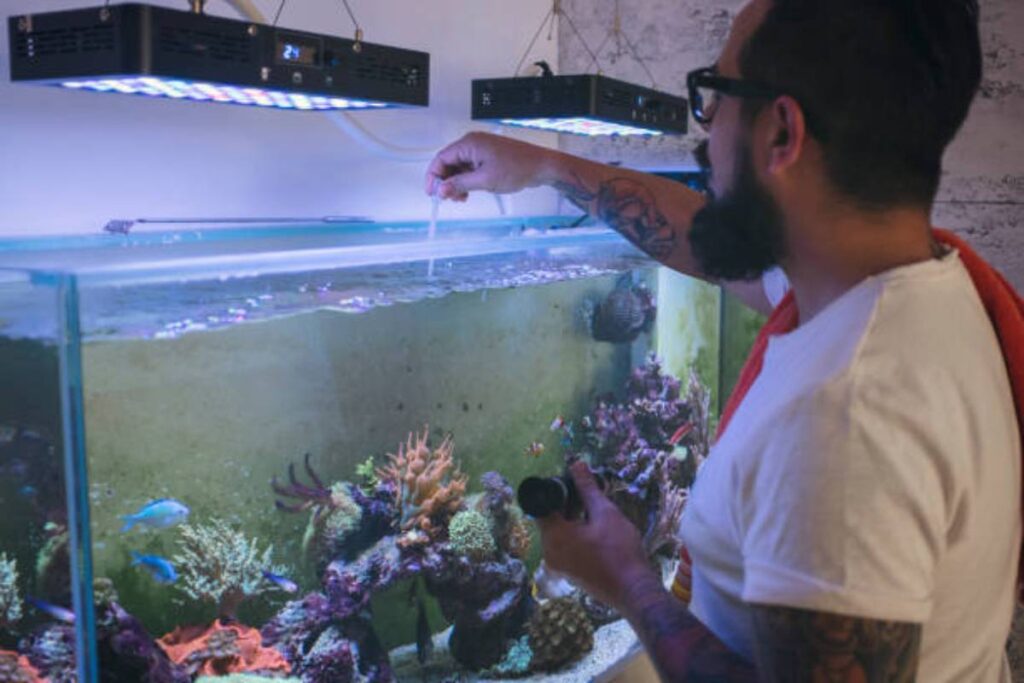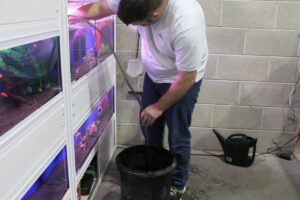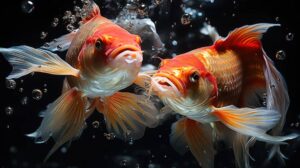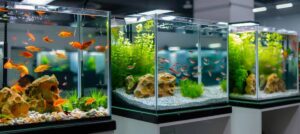The Pets Care Blog

How to Test Aquarium Water Correctly: A Beginner’s Guide to Water Quality Monitoring
Have you ever noticed your fish acting strangely, even though the tank looks spotless? Maybe they’re gasping at the surface, hiding more than usual, or showing dull colours. These can all be signs of something you can’t see — poor water quality.
Crystal-clear water can still be toxic beneath the surface. That’s why aquarium water testing is one of the most important habits every fish keeper needs to build. Whether you’re caring for neon tetras or angelfish, knowing what’s happening chemically in your tank keeps your fish healthy, your water stable, and your setup thriving long-term.
In this guide, we’ll walk through everything you need to know about water quality monitoring — from what to test, how to use fish tank test kits properly, and how to interpret your results. Whether you’re a first-time aquarist or levelling up your care routine, this article will give you clear, reliable guidance that fits into your weekly maintenance schedule.
Why Is Aquarium Water Testing So Important?
Your aquarium is a closed ecosystem. Unlike rivers or lakes, waste doesn’t get flushed away naturally. Instead, it builds up, and without routine testing, you could be sitting on an invisible time bomb of toxins.
Water testing lets you:
- Catch problems before fish get sick
- Avoid ammonia or nitrite spikes
- Track your nitrogen cycle progress
- Maintain safe, stable water parameters
- Adjust feeding, water changes, or filtration based on data
Simply put, water testing bridges the gap between guesswork and smart, proactive fish care.
Key Water Parameters You Should Be Testing
You don’t need a chemistry degree, but you do need to understand what to look for. Here are the most crucial parameters to track, especially in the first 3 months of a tank’s life.
1. Ammonia (NH₃)
- Source: Fish waste, uneaten food, decaying plants
- Why it matters: Highly toxic — even at 0.25 ppm
- Safe range: 0 ppm
2. Nitrite (NO₂)
- Source: By-product of ammonia breakdown
- Why it matters: Also toxic; affects fish respiration
- Safe range: 0 ppm
3. Nitrate (NO₃)
- Source: Final product of the nitrogen cycle
- Why it matters: Less harmful but builds up over time
- Safe range: Below 40 ppm (ideally under 20 ppm)
4. pH (Potential of Hydrogen)
- Why it matters: Measures acidity or alkalinity; affects fish stress and toxin levels
- Typical range: 6.5–7.5 (varies by species)
5. GH (General Hardness) and KH (Carbonate Hardness)
- Why they matter: Affect mineral content, buffering capacity, and pH stability
- Ranges vary: Research based on species (e.g., soft water for tetras, harder for livebearers)
If your tank is newly set up, you’ll also want to track your cycle progress. Learn more in What is the Nitrogen Cycle and Why It Matters.
Types of Aquarium Test Kits Explained
Not all test kits are created equal. Here’s how to choose what suits your setup.
1. Liquid Test Kits (Best Accuracy)
- Use drops and colour charts.
- Measure multiple parameters.
- Cost-effective in the long run.
Recommended for: All aquarists, especially during cycling.
2. Test Strips (Quick, Less Precise)
- Dip-and-read format.
- Convenient but less accurate.
- Results can be affected by water temperature or lighting.
Recommended for: Quick checks or backup confirmation.
3. Digital Testers (High-End)
- Electronic probes for pH, temperature, or salinity.
- More expensive and very accurate.
- Calibrated regularly.
How to Use Fish Tank Test Kits Correctly
Let’s go through a basic test using a liquid test kit — the most popular and reliable choice for beginners and pros alike.
What You’ll Need:

- Clean test tubes
- Liquid test kit (API Master Kit is a common choice)
- Colour chart
- Timer or phone stopwatch
- Notebook or app for tracking results
Steps to Follow:
- Wash your hands before starting (no soap residue).
- Collect a water sample mid-tank, not near the filter or surface.
- Add the reagent drops exactly as directed (shake bottles well first).
- Cap and shake the tube gently to mix.
- Wait the specified time (typically 5 minutes).
- Hold against the colour chart in natural light for best accuracy.
- Record your results immediately.
Repeat for each parameter. Don’t reuse the same test tube without rinsing it thoroughly with tank water.
When and How Often Should You Test Aquarium Water?
Your testing frequency will change as your tank matures.
During the First Month (Cycling Phase)
- Test every 2–3 days for ammonia, nitrite, and nitrate.
- Look for the transition from ammonia → nitrite → nitrate.
After Cycling Completes
- Test weekly to monitor overall water quality.
- Especially after:
- Water changes
- Adding new fish
- Filter cleaning
- Algae blooms or plant die-off

For Mature Tanks (3+ months)
- Test every 1–2 weeks or more if something seems off.
Understanding and Interpreting Your Test Results
So you’ve got the colour in front of you — now what?
Safe Parameters at a Glance:
| Parameter | Safe Range | Danger Sign |
| Ammonia | 0 ppm | > 0.25 ppm |
| Nitrite | 0 ppm | > 0.25 ppm |
| Nitrate | < 40 ppm | > 80 ppm |
| pH | 6.5–7.5 (general) | < 6.0 or > 8.0 |
| GH & KH | Varies by fish | Sudden drops |
Red Flags to Watch For:
- Sudden ammonia spike: Overfeeding or a dead organism
- High nitrite: Bacterial imbalance
- Nitrate over 80 ppm: Infrequent water changes
- pH swing: Can shock fish — test your tap water too
If things look off, take action. Reduce feeding, perform partial water changes, and monitor over the next few days.
Tips for Keeping Your Water Parameters Stable
Testing is just the first step — prevention is key.
Here’s how to keep your water chemistry balanced:
- Feed lightly. Overfeeding = more waste = more ammonia.
- Don’t overstock. More fish means more waste.
- Do regular partial water changes (20–30% weekly).
- Use a good filter with biological and mechanical media.
- Avoid sudden changes in pH or temperature.
- Test your tap water regularly if using it for top-offs or changes.
Still unsure how to care for your filter? Read up on Filter Maintenance: How Often Should You Clean It.
Tracking Your Results Over Time
Water testing becomes more powerful when you start to notice patterns.
- Use a spreadsheet, app, or notebook to log results.
- Note the date, time, and any changes (new fish, plant removal, etc.).
- Graphing nitrate trends can help you time water changes more effectively.
Over time, you’ll gain a sixth sense of your tank’s rhythm.
Common Mistakes to Avoid
Even seasoned fishkeepers can miss the basics. Here’s what to steer clear.
- Skipping the wait time after adding test drops
- Comparing colour in dim or artificial light
- Using expired reagents
- Not shaking test bottles or tubes properly
- Using test tubes with leftover chemicals
A few minutes of careful attention can prevent hours of troubleshooting later.
Conclusion: Clarity Begins with Testing
A healthy aquarium isn’t just about what you see. It’s about what’s happening behind the scenes — and regular water testing is your window into that invisible world.
With the right tools and a steady routine, you’ll quickly go from confused to confident. You’ll catch issues early, understand your tank’s unique cycle, and support your fish with science-backed care.
Ready to start testing smarter, not harder?
Pick up a reliable test kit, set a weekly reminder, and take 10 minutes to understand what your water’s really telling you. If you’re already testing, share your setup or test kit tips in the comments below — we’d love to hear how you stay on top of tank health.









